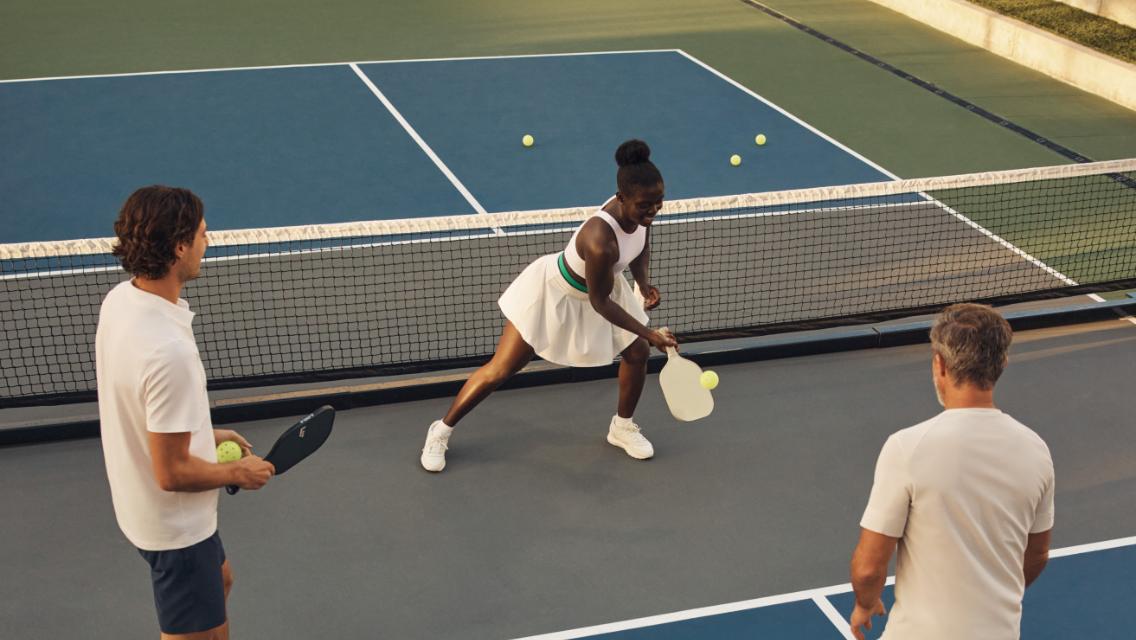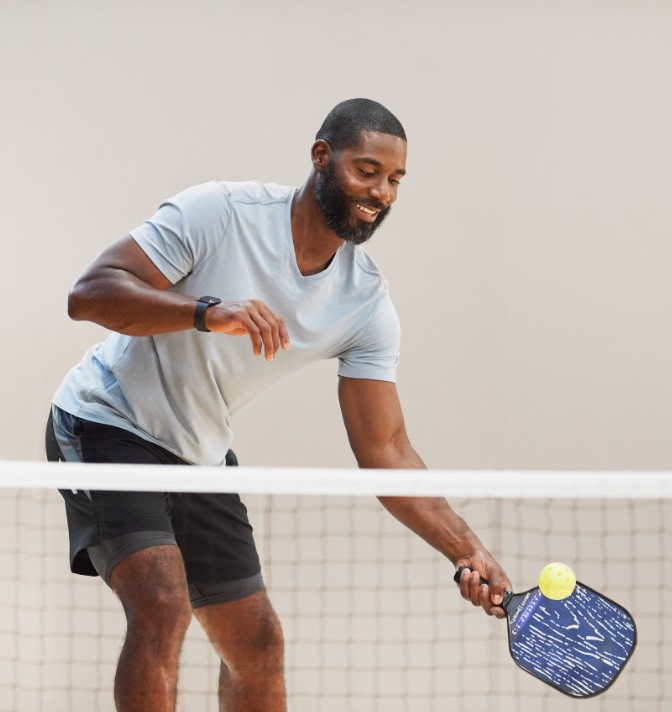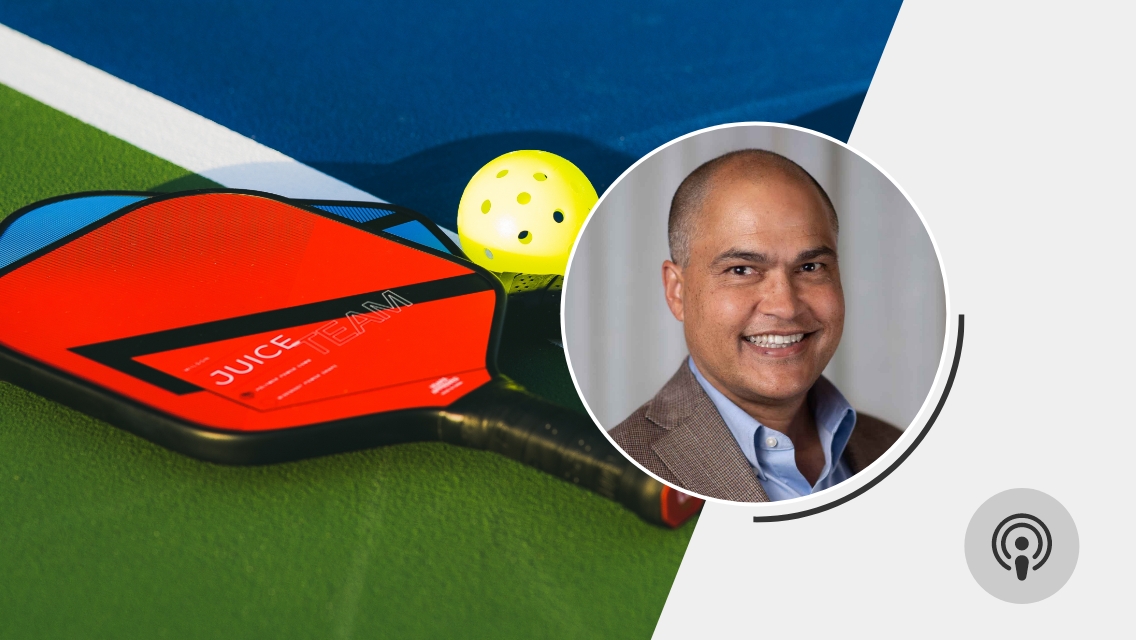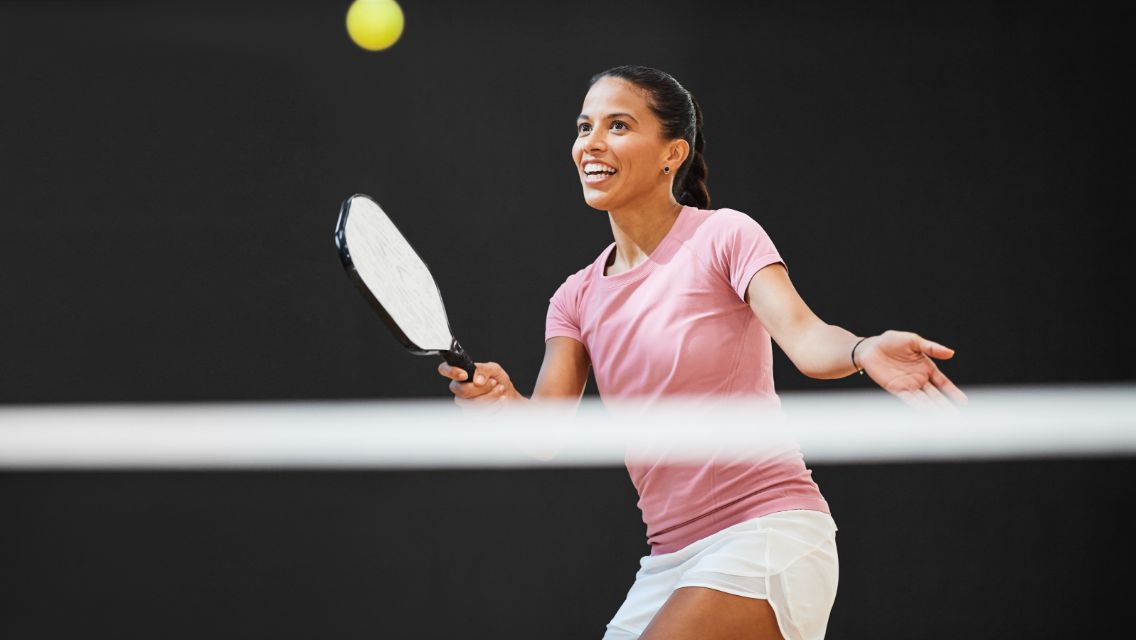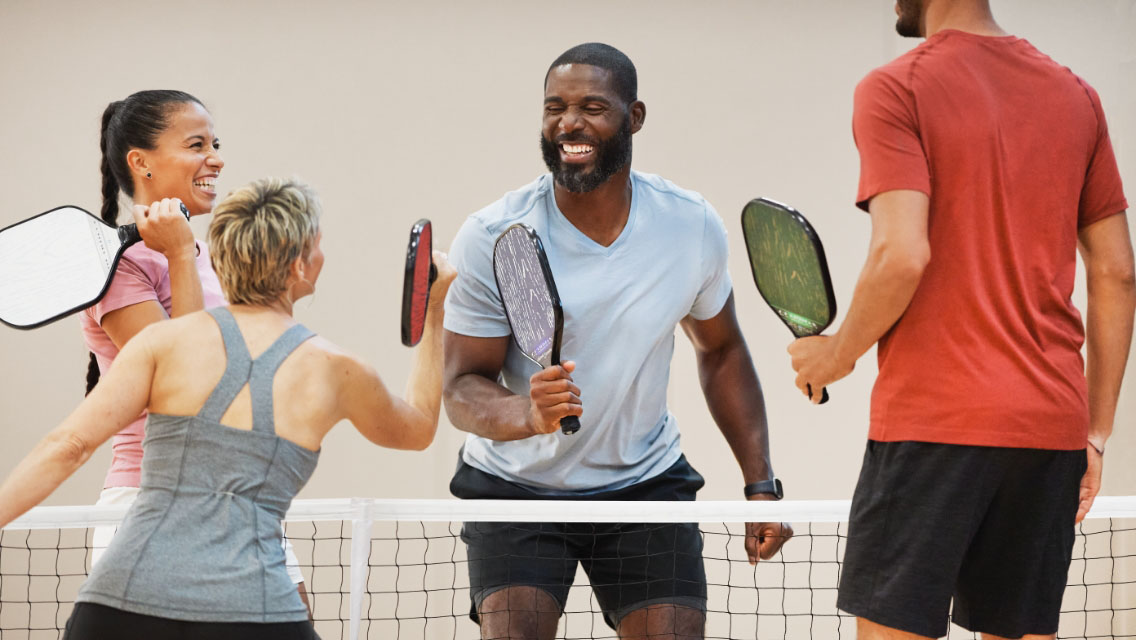From young kids to older adults, beginners to pros, and fierce competitors to social players, people of all ages, abilities, and levels of competitiveness are playing pickleball. And there’s a reason for its widespread adoption: It’s one of the rare sports that offers play for a large population.
The ease and benefits of the game contribute, too. “Between the size of the court and the rules and method of play, it’s really easy for anyone to learn — and I mean anyone,” says David Dutrieuille (pronounced do-trell), a pickleball pro consultant with Life Time.
“There are few things in life that I’ve found that bring together the necessary components for a fun yet meaningful experience, and pickleball seems to hit all of those,” he continues. “You’re physically active, mentally engaged, and feel a sense a belonging. It’s hard not to fall in love with it.”
Ready to pick up a paddle and play? Dutrieuille shares what you need to know about how to get started with pickleball.
How to Play the Game
Understand the nonvolley zone.
This area of the court is a 14-foot space in the center that is cut in half by the net; in pickleball slang, is referred to as “the kitchen.” Dutrieuille encourages beginners to call it the nonvolley zone, though, to serve as a reminder of the rules of the space.
“You’re not allowed to volley the ball — which simply means to hit a ball out of the air — when standing in that 7-foot-space on your side of the net,” instructs Dutrieuille. “You can, however, allow the ball to bounce there, then step into the space and hit it. If you’re standing behind the nonvolley zone line, you’re free to volley the ball.”
Assume your position.
On the serving team, the server and their teammate will stand at the back of the court near the baseline.
On the opposing team, the player directly across from the server stands behind the nonvolley zone line, while their teammate stands near the baseline to receive the serve.
When gameplay has started and the two-bounce rule has been met (more on this below!), all players are free to travel their side of the court as they wish.
Start with the serve.
In pickleball you serve diagonally, just as you would in tennis. The first serve of the game happens from the northwest corner of the court. “A fun fact,” shares Dutrieuille, “is that rule pays homage to the sport’s origin in Bainbridge Island in Washington, a short ferry ride from Seattle, which is in the northwest corner of the United States.”
The team who makes the first serve of the game only gets one serve. Then, after the first serve of the game, each team is allowed two opportunities to serve, one opportunity per individual. (This differs from tennis, where each individual might get two serves.)
“People are often confused as to why you only get one serve to start,” says Dutrieuille. “My best guess is because when you get a first serve, your team has an advantage because you have the chance to score first. In pickleball, they’ve mitigated that advantage by only allowing a team one serving opportunity.”
When serving, your paddle needs to make contact with the ball below your belly button. The ball must cross over the net and the nonvolley zone line — but if you hit any other line on the court, the ball is still considered good.
“A cheeky rule a lot of people don’t know,” explains Dutrieuille, “is that when you’re serving, if you mishit the ball and hit your opponent, that technically is the serving team’s point.”
Follow the two-bounce rule.
Say you have two opposing pickleball players, Emilia and George, and Emilia is serving to George. When Emilia serves the ball and it travels into the box on the diagonal side, behind the nonvolley zone, it needs to bounce once, and then George must hit the ball. If the ball bounces twice before George hits it, it’s considered a dead ball.
Once George hits it back to Emilia, the ball can land anywhere on the court, but Emilia must again let the ball bounce once before hitting it back to George. From this point on, players are allowed to hit the ball out of the air without waiting for a bounce. This series of events is known as the two-bounce rule.
Say it like you see it.
Assuming a ref isn’t present, all players are responsible for line-calling duties. If Emilia and Louise are teammates and George and Tyler are their opponents, it’s Emilia’s and Louise’s right to call if George or Tyler’s return hit goes out of bounds — and George and Tyler can’t argue it.
Call the score.
When you have possession of the ball and are serving, you call the score in this order: your team’s score, the opposing team’s score, then your team’s serving opportunity. For example, if Emilia is serving and her team has five points, George’s team has four points, and she’s the first server, she would say, “5-4-1.” If she doesn’t score, it’s now Louise’s turn to serve; Louise would then say, “5-4-2.”
When you’re the serving team, you can score as many points as you’re able to in your team’s opportunity. If you “win a point” while the other team is serving, you do not get a point, but you do get the serving opportunity back if both opponents fail to score on their serves.
Play singles or doubles.
“Pickleball, by default, is a doubles game,” says Dutrieuille, though you can choose to play singles rather than doubles. For the most part, the rules stay the same.
“The things that become modified,” explains Dutrieuille, “is that you only get one serving opportunity rather than two. And your opponent’s ability to hit a passing shot increases without another body on the court — how quickly you can get to the net really begins to define a player’s ability in singles.”
What pickleball equipment do I need?
The essentials are a paddle for each player and one pickleball. Dutrieuille emphasizes that one of the benefits of pickleball is that the cost of entry is so minuscule: Unlike tennis or golf, for example, the price of the equipment isn’t necessarily an indicator of its quality.
“The best female player in the world plays with a $100 paddle, and the best male is playing with a $225 paddle,” says Dutrieuille. “You can easily buy a pickleball set for $60. I would suggest trying a paddle before you buy one because they are personal to preference.”
If you’re playing at Life Time, paddles and pickleballs are provided.
If it’s an option, Dutrieuille recommends wearing tennis-specific court shoes. The next best choice would be basketball or indoor volleyball shoes. If those are available to you, cross-training or running shoes will suffice; they are just not as ideal because they don’t offer a ton of, or potentially any, lateral support.
As far as clothing, Dutrieuille says, “What I always say is that you want to wear what you’re going to be most comfortable moving and grooving in.”
How to Play Pickleball at Life Time
There are four primary ways to play pickleball at Life Time:
Intro to Pickleball
Led by a knowledgeable pickleball coach, this one-hour class is designed to help you learn the basics of how to play the sport. You’ll focus on scoring, the rules of play, and the intricacies of the game. Up to two sessions of this class is complimentary for all members.
Open Play
This is a series of set times on club schedules each week where you can reserve a spot to mix in and play, whether with friends or other members. Games are played four to a court, with each match going to 11 points; you must win by a minimum of two points. After each game is finished, if others are waiting to play, a new foursome will rotate in. If there are less than four people waiting, any willing participants will go off the court to allow the waiting pickleballers to play.
Open Play is for all ages and skill levels. However, there are some clubs that also offer different skill-based levels during Open Play. These levels are based on a scale of 1.0 to 5.5-plus. Dutrieuille suggests assessing your level based on the following guidelines (you can also find skill-assessment questionnaires on the USA Pickleball website):
- 1.0–2.5: You’re a beginner. As you get closer to the end range of this scale, you learn how to keep score, understand serving positions, and can successfully serve the ball four out of 10 times.
- 2.5–3.0: You’re at a beginner-intermediate level. You’re more confident in hitting the ball out of the air, hitting ground strokes, and blocking shots.
- 3.0–3.5: You’re generally considered intermediate. You’re not as afraid of the nonvolley zone and have an impetus to enjoy getting closer to the net. You start exploring different shots, such as sideline shots and lobs — perhaps even attempting a dink here and there.
- 3.5–4.0: You’re generally considered to be at an intermediate-advanced level. This is where the game starts to take a different shape, says Dutrieuille. You’re comfortable and confident with ground strokes, you hit the ball hard, you want to get to the nonvolley zone line, and are attempting to do a third shot drop. Your ability to manipulate and slow down the game increases.
- 4.0–4.5: You know where you want to hit the ball and are directionally intent — and you get it there about 60 percent of the time. You can easily serve successfully eight out of 10 times. You’re able to execute a third shot drop and a reset shot about 50 percent of the time.
- 5.0–5.5: You’re able to perform a third shot drop and a reset about 80 to 90 percent of the time.
- 5.5+: You’re at a pro level. You’re executing all shots at a rate of 90 percent or higher.
Open Play is complimentary.
Mixers
This format is similar to Open Play, except that in addition to playing pickleball, you may also receive a drink ticket and have an added chance to meet new people. “A mixer is a phenomenal way to have a low-stress pickleball experience and a low-committal opportunity to meet other members,” says Dutrieuille. Mixer pricing varies by club and the type of Mixer offered.
Reserve a Court
This allows you to play and stay with the other player(s) you come with. Reserve a court for up to two hours and play as many games as you’d like. You’re able to invite up to six people on your reservation, but must limit the people on the court to four at a time. Reserving a court is complimentary for signature members, otherwise the cost is $20 per hour for the court.
Most Life Time clubs also offer lessons and clinics for those who want to advance their pickleball skills, along with leagues, tournaments, and other social events.
